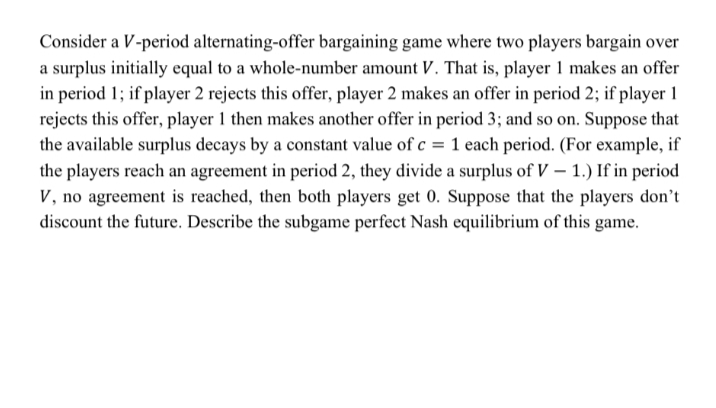Consider a V-period alternating-offer bargaining game where two players bargain over a surplus initially equal to a whole-number amount V. That is, player 1 makes an offer in period 1; if player 2 rejects this offer, player 2 makes an offer in period 2; if player 1 rejects this offer, player 1 then makes another offer in period 3; and so on. Suppose that the available surplus decays by a constant value of c = 1 each period. (For example, if the players reach an agreement in period 2, they divide a surplus of V – 1.) If in period V, no agreement is reached, then both players get 0. Suppose that the players don't discount the future. Describe the subgame perfect Nash equilibrium of this game.
Consider a V-period alternating-offer bargaining game where two players bargain over a surplus initially equal to a whole-number amount V. That is, player 1 makes an offer in period 1; if player 2 rejects this offer, player 2 makes an offer in period 2; if player 1 rejects this offer, player 1 then makes another offer in period 3; and so on. Suppose that the available surplus decays by a constant value of c = 1 each period. (For example, if the players reach an agreement in period 2, they divide a surplus of V – 1.) If in period V, no agreement is reached, then both players get 0. Suppose that the players don't discount the future. Describe the subgame perfect Nash equilibrium of this game.
Chapter13: General Equilibrium And Welfare
Section: Chapter Questions
Problem 13.12P
Related questions
Question

Transcribed Image Text:Consider a V-period alternating-offer bargaining game where two players bargain over
a surplus initially equal to a whole-number amount V. That is, player 1 makes an offer
in period 1; if player 2 rejects this offer, player 2 makes an offer in period 2; if player 1
rejects this offer, player 1 then makes another offer in period 3; and so on. Suppose that
the available surplus decays by a constant value of c = 1 each period. (For example, if
the players reach an agreement in period 2, they divide a surplus of V – 1.) If in period
V, no agreement is reached, then both players get 0. Suppose that the players don't
discount the future. Describe the subgame perfect Nash equilibrium of this game.
Expert Solution
This question has been solved!
Explore an expertly crafted, step-by-step solution for a thorough understanding of key concepts.
This is a popular solution!
Trending now
This is a popular solution!
Step by step
Solved in 2 steps

Knowledge Booster
Learn more about
Need a deep-dive on the concept behind this application? Look no further. Learn more about this topic, economics and related others by exploring similar questions and additional content below.Recommended textbooks for you

